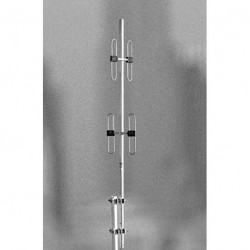Your problem is solved, for the moment. If you are interested in finding out what the issues are, keep reading.
With most antennas, the limiting factor is usually the SWR at the two operating frequencies. As mmckenna advised, focus on the SWR at the transmit frequency as that will protect your transmitter from excessive SWR, otherwise heat. The receiver mismatch is less of a concern as it will not cause damage, only a slight but measurable reduced performance. The operating bandwidth is usually limited by the method used to match the feedline to the antenna. Even field tunable antennas suffer from limited operating bandwidth.
However, there are antennas that are designed for wide operating bandwidths, such as 138-174 MHz. These are usually dipoles with a special matching design. An example is a Comprod 871-70-LM or Sinclair SD210 antenna. These dipoles can be stacked to achieve more gain, while preserving the wide operating bandwidth. An example of the antenna feedline match is below.
The antenna you purchased is a collinear design. This design has limited operating bandwidth from both SWR and beam-tilt issues. At the center operating frequency, the radiating beam is at the horizion. At the highest operating frequency, the beam is tilted up a few degrees and at the lowest operating frequency the beam is tilted down a few degrees. With your antenna, this is not a problem because it has very little gain. Collinear antennas with more gain sometimes use this condition to create down-tilt, for some mountain top sites.
Mobile radio systems are expensive to build, but you can get more range & performance from using the best antenna & feedline than any other way. At the repeater, quality gain antennas improve both your transmit and receive performance. Quality feedline, like Heliax cable preserves the signal between the repeater and antenna. Any loss in the feedline cannot be made up for with amplifers or anything else.
Last, the gain advertised is rarely accuract, as they often offer no reference. The standard references are dBi and dBd. If they just say dB, it means nothing as the reference is unstated.




